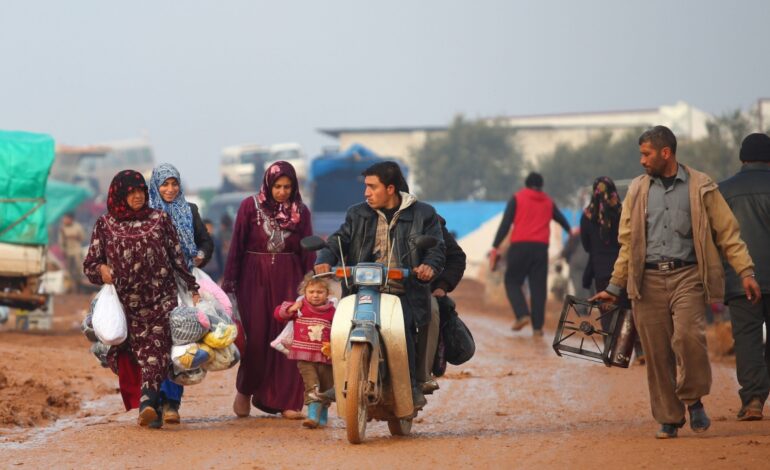Syria’s Path to Refugee Repatriation: Challenges Ahead

The question of refugee repatriation in Syria is gaining urgency as the transitional government under Ahmed al-Sharaa seeks to address the plight of millions displaced by years of conflict. With approximately 14 million Syrians currently displaced worldwide, including 6 million in neighboring countries and Europe, the international community is closely watching how Syria navigates this complex issue.
In recent months, several European Union (EU) nations have begun to suspend asylum claims for Syrian refugees, responding to domestic pressures that call for a reevaluation of their refugee policies. The emergence of a transitional government and a reduction of certain US and EU sanctions have led to claims that Syria is now safe for the return of its citizens. Yet, significant hurdles remain before any large-scale repatriation can occur.
Assessing Conditions for Return
Since the fall of the Assad regime, data from the United Nations High Commissioner for Refugees (UNHCR) indicates that nearly 500,000 Syrians have returned from neighboring countries. However, these returnees face numerous challenges, including ongoing insecurity, sporadic violence, and a lack of essential services. Many returnees struggle to reintegrate due to economic instability and housing shortages, which cast doubt on the feasibility of widespread repatriation.
Despite some improvements in security, Syria’s social and political landscape remains fragile. The risk of renewed displacement is heightened if conditions do not stabilize. Therefore, any repatriation strategy should be phased and aligned with on-the-ground realities.
Social Divisions and Governance Challenges
Syria continues to grapple with deep-seated social divisions that threaten stability. Although the transitional government has made strides by forming a more inclusive cabinet and promoting minority representation, targeted attacks on groups such as the Alawites and Druze persist. The bombing of Mar Elias Church in Damascus, which resulted in the deaths of 25 civilians, exemplifies the ongoing threats faced by minority communities.
The transitional government’s efforts, including religious fatwas aimed at discouraging revenge killings, are commendable but insufficient to foster the conditions necessary for large-scale repatriation. Returnees may face hostility from those who view them as former adversaries, exacerbating tensions and potentially igniting further conflict.
The path to successful repatriation hinges on more than just governmental gestures. It requires local reconciliation efforts, guarantees of safety for minorities, and the restoration of essential services and livelihoods. Without these foundational elements, returnees could encounter instability and discrimination, jeopardizing both their safety and the humanitarian principles governing refugee rights.
International support remains crucial for preparing Syria for this transition. Gulf states like Saudi Arabia, Qatar, and the UAE are beginning to provide aid, while the EU has pledged €2.5 billion for stabilization efforts. This funding must be strategically directed toward community peacebuilding, security initiatives, and reintegration programs that address Syria’s diverse societal needs.
Healthcare and Landmine Challenges
Syria’s healthcare system is in crisis following years of war and sanctions that devastated its infrastructure. Hospitals and clinics are frequently understaffed and lack essential resources, especially in rural areas where access is severely limited. The ongoing crisis is compounded by the presence of landmines and improvised explosive devices (IEDs), which have resulted in over 1,000 casualties in just six months, with children making up nearly one-third of the victims.
Sustainable recovery must focus on rebuilding local healthcare capacity. This involves training and retaining local medical personnel and ensuring that aid complements rather than replaces Syrian capacities. Collaboration with organizations like the Syrian Arab Red Crescent will be vital to fostering resilience and accountability.
Moreover, the transitional government must work with international donors to establish systems for surveying and clearing landmines and explosive remnants of war. Without addressing these urgent issues, an influx of returnees could overwhelm the healthcare system and exacerbate the existing humanitarian crisis.
Securing Property Rights for Returnees
A significant obstacle for returning refugees is the lack of secure property rights. The UN Syria Commission has reported widespread looting and destruction of property, primarily by former government forces. Laws enacted during the Assad regime, such as Legislative Decree No. 66 (2012) and Law No. 10 (2018), have facilitated the state expropriation of property without due process, further complicating the return process.
The transitional government has not yet indicated whether it will amend or repeal these laws, but increasing public pressure suggests a potential shift toward reform. Organizing property claims committees at the municipal level is insufficient; a regional or national approach, with international oversight, will be necessary to ensure consistency and protect the rights of displaced individuals.
The experience of Bosnia and Herzegovina post-conflict offers a useful reference. A neutral, internationally supported property claims commission could help resolve disputes and facilitate safe returns, while also attracting foreign investment crucial for reconstruction.
Conditions for Safe Repatriation
Syria will be ready to welcome back its displaced population only when several key conditions are met. These include demonstrable protections for minorities, a resilient healthcare system, clearance of explosive remnants, and secure property rights. Repatriation must be gradual, voluntary, and carefully monitored to avoid reigniting conflict.
A comprehensive repatriation plan developed by the European Union should include conditional aid and sanctions relief based on demonstrable progress toward established benchmarks. A civilian monitoring mission under UN auspices could oversee the return process, ensuring transparency and accountability while engaging with Syrian civil society.
In conclusion, the road to repatriation for Syrian refugees is fraught with challenges. A carefully coordinated approach, bolstered by significant international support, is essential to create conditions that allow for a safe and dignified return. Without these measures, the prospect of repatriation remains uncertain, and millions of displaced Syrians will continue to await the opportunity to return home.






